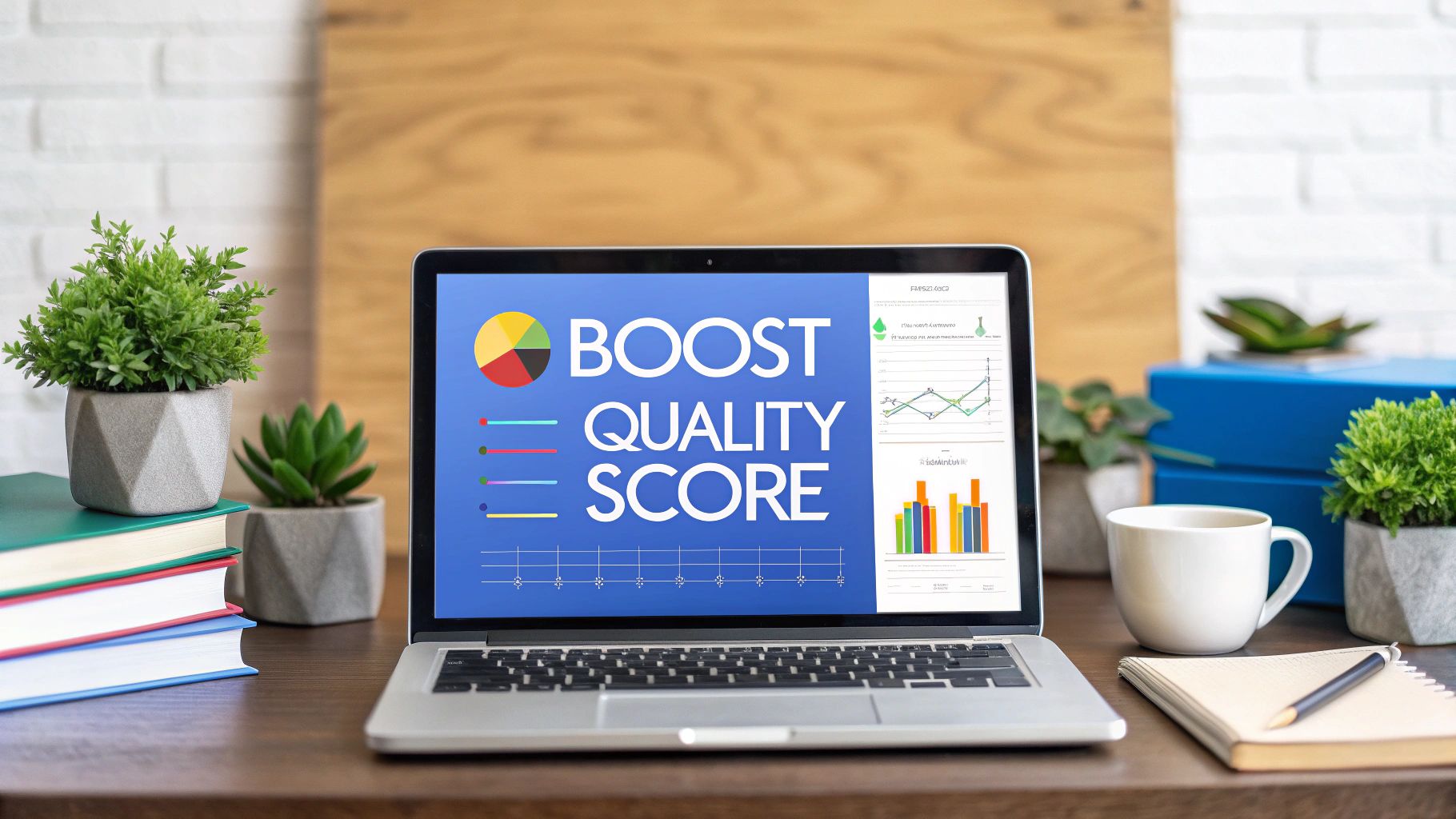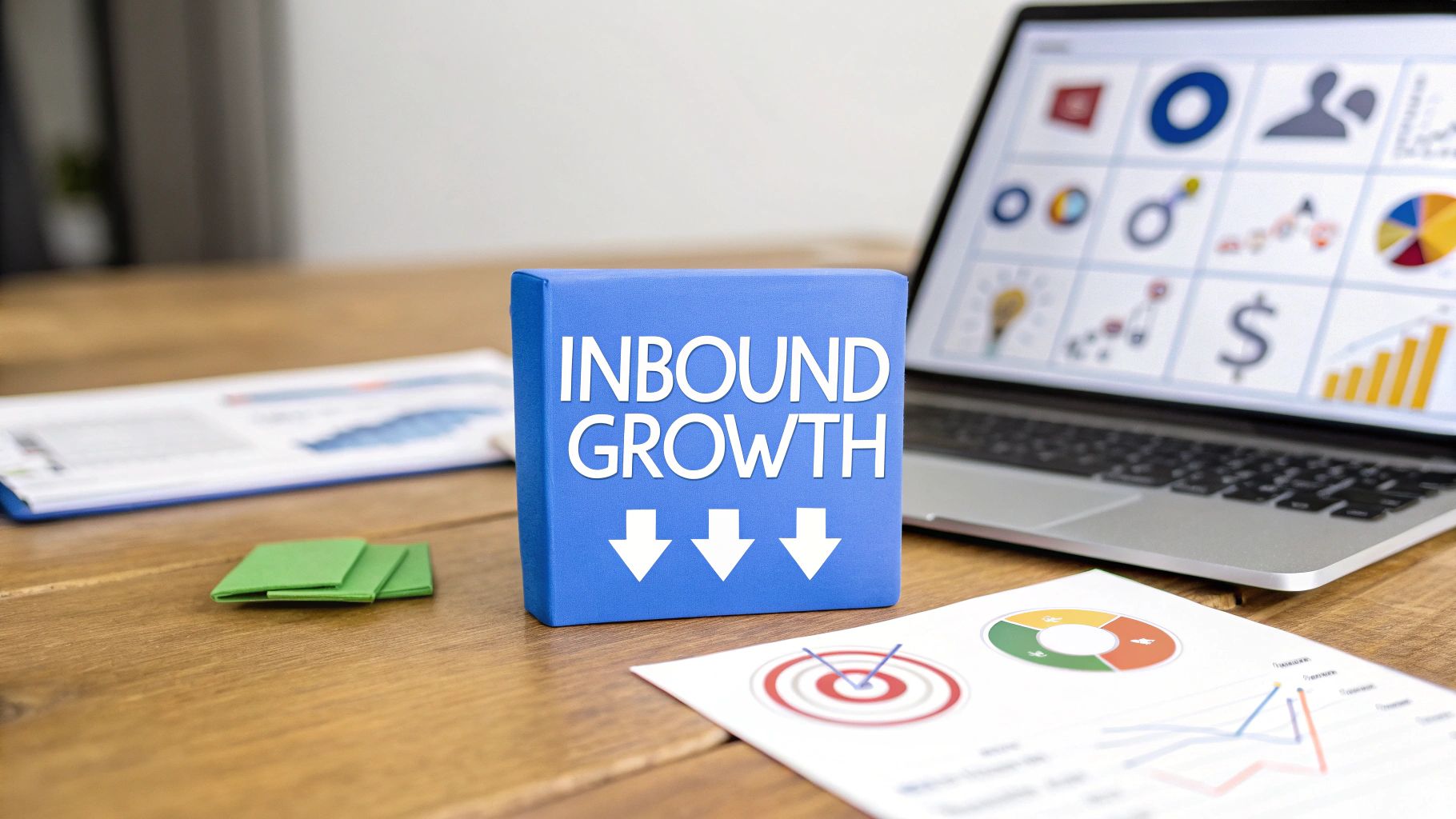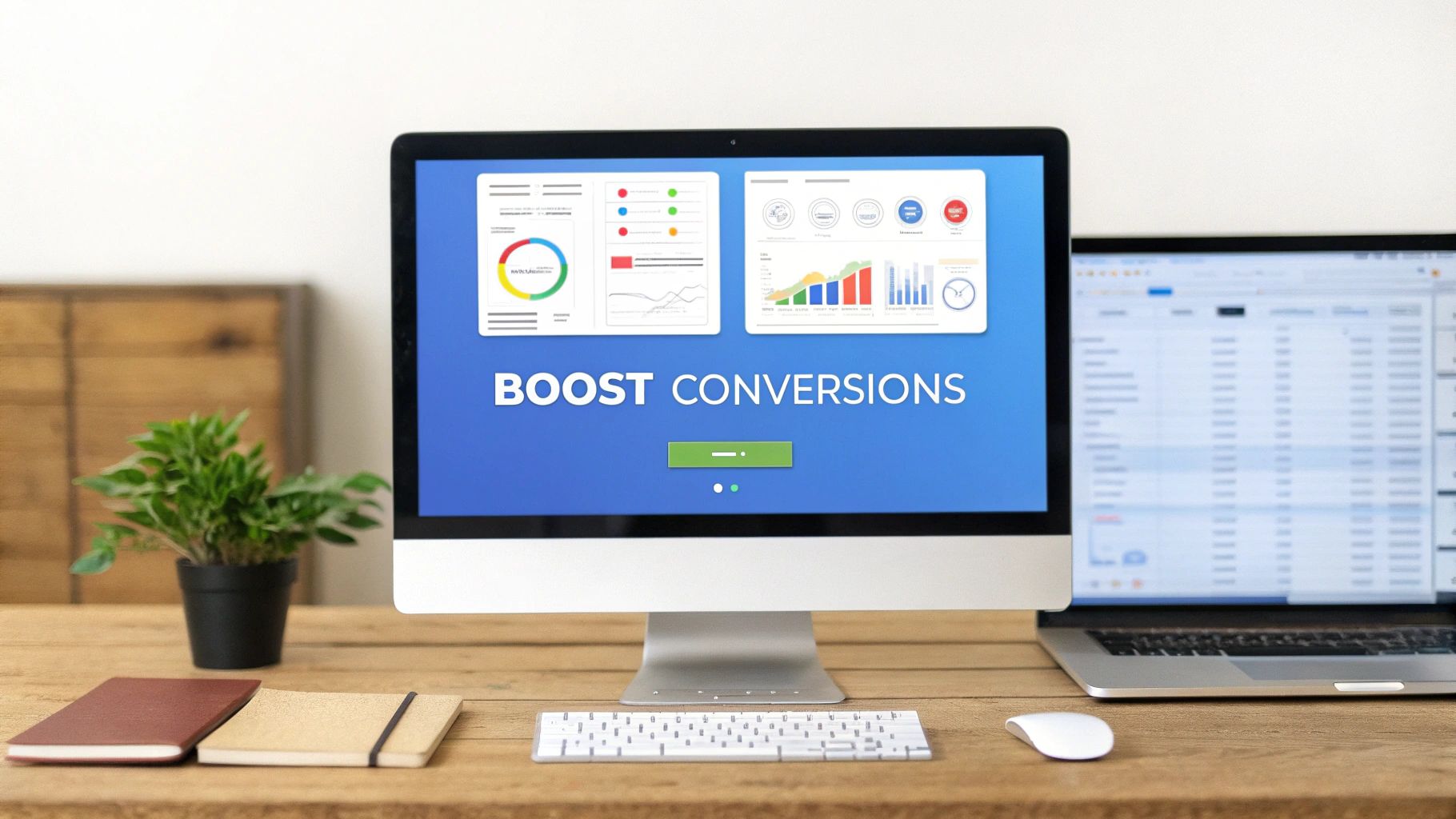Summary
Meta Description: Ready to lower your ad costs and improve rankings? Learn how to improve your Google Ads Quality Score with our expert guide on ad relevance, CTR, and landing pages.If you want to move the needle on your Quality Score, you have to nail three things: **Expected Click-Through Rate (eCTR)**, **Ad Relevance**, and **Landing Page Experience**. It's a constant feedback loop. You're always tweaking your ads, keywords, and landing pages to create a perfect match for what someone is searching for.## Why is a High Quality Score Your Secret Weapon in Google Ads?Let's get one thing straight: Quality Score isn't just another vanity metric. It's the engine that drives the efficiency and cost-effectiveness of your entire Google Ads account. In an era of automated bidding, understanding and improving this score is one of the few real competitive advantages you have left. Think of it as your direct line to understanding how Google sees the quality of your ads, keywords, and pages.A high Quality Score directly fuels better campaign performance and, ultimately, a healthier bottom line. In fact, you can [calculate marketing ROI](https://www.brandbooster.ai/blog/how-to-calculate-marketing-roi) to see just how big of an impact small improvements can make. Simply put, a higher score means you pay less for better ad positions. It's that critical.> The goal isn't necessarily to chase a perfect 10/10 on every keyword. It's about mastering the art of creating a seamless, valuable journey for your users—from the moment they type in a search to the second they convert on your site.So, how does Google actually figure this all out? It boils down to three core pillars that have to work in harmony.### The Three Pillars of Quality ScoreYour score is a blend of performance signals that tell Google whether your ad is a solid match for a search. Each of these components gets its own rating: "Above average," "Average," or "Below average." This is where you diagnose the real problems.* **Expected Click-Through Rate (eCTR):** This is Google's prediction of how likely someone is to click your ad when it appears. It’s heavily influenced by how compelling and relevant your ad copy is to the keyword.* **Ad Relevance:** This measures how tightly your ad's message aligns with the user's search query. Does your ad directly answer the question they’re asking?* **Landing Page Experience:** After the click, does the landing page deliver on the promise made in the ad? Things like load speed, mobile-friendliness, and clear, relevant content are make-or-break here.Understanding these three components is the first real step toward diagnosing and fixing what’s holding your account back. Are you ready to dive in?### The Evolution to AI-Driven Quality AssessmentThe game has changed a bit. In **2025**, Google rolled out an AI-driven ad quality prediction model, marking a significant shift in how this metric is determined. It moved away from relying so heavily on historical data (like past click-through rates) and now leans into a predictive assessment of the user experience *before* an ad even shows.The three core pillars are still the foundation, but Google's machine learning now forecasts whether an ad *will* provide a good experience. It's evaluating things like landing page relevance, how easy the page is to navigate, and whether the ad's promise truly lines up with the page's content. This forward-looking approach makes creating a genuinely high-quality, user-focused experience more critical than ever before.## How to Improve Ad Relevance for a Better Quality Score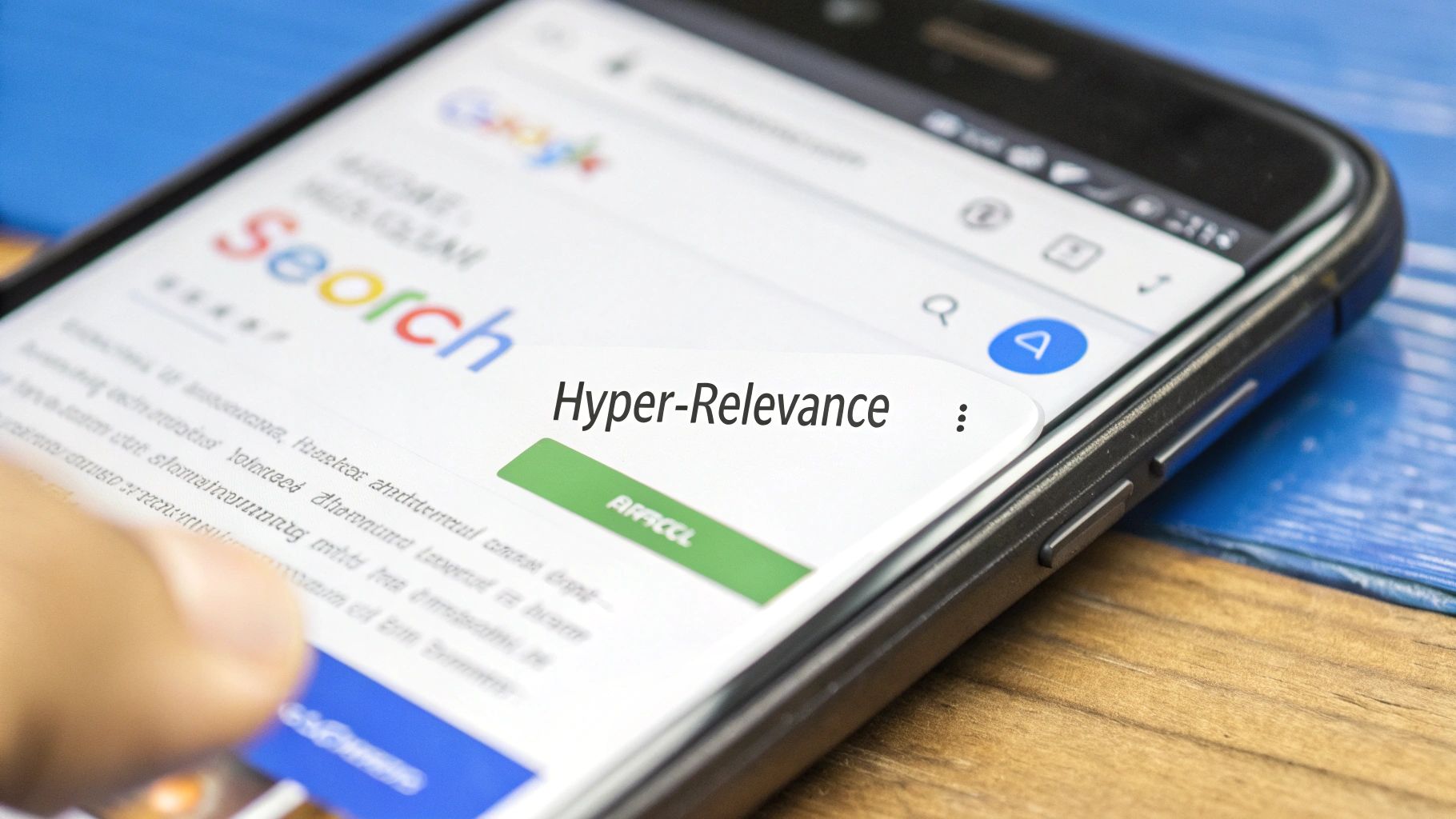Ad relevance is where the magic happens. It’s you proving to Google that your ad is the absolute best answer for someone's search. Think of it as the connective tissue linking a user’s query to your solution.When you get this right, Google rewards you. We're talking higher Quality Scores, cheaper clicks, and better ad positions.Forget old-school keyword stuffing. We're building a campaign structure that practically forces relevance by creating a seamless journey from keyword to ad copy to landing page. This tight alignment is what will bump your ad relevance score from "Average" right up to "Above average."### Tightly Themed Ad Groups: The Modern Alternative to SKAGsFor years, **Single Keyword Ad Groups (SKAGs)** were the go-to strategy. The logic was solid: one keyword per ad group meant you could write perfectly tailored ad copy every time. It was the ultimate way to achieve relevance.But things have changed. Google’s algorithm now leans heavily on close variants and broader intent matching, making pure SKAGs a management nightmare. The better, more scalable approach today is the **tightly themed ad group**. Instead of a single keyword, you group a small, highly related set of keywords together.Here’s a quick example of what that looks like:* **Example Themed Ad Group:*** **Keywords:** "eco-friendly running shoes," "sustainable running sneakers," "recycled material running shoes"* **Ad Headline:** Eco-Friendly Running Shoes* **Ad Description:** Run sustainably with our recycled material sneakers. Shop now.This structure still gives you that hyper-relevant ad copy without forcing you to create and manage hundreds of nearly identical ad groups. It lets you work *with* Google's algorithm, not against it.To keep things clear, here’s a quick breakdown of what goes into Ad Relevance and why each part matters.#### Ad Relevance Component BreakdownThis table summarizes the core elements that contribute to Ad Relevance and how they influence your Quality Score.| Component | Description | Direct Impact on Quality Score || :--- | :--- | :--- || **Keyword-Ad Copy Alignment** | The degree to which your ad copy (headlines, descriptions) matches the keywords in the ad group. | **High.** This is the primary signal Google uses to determine relevance. || **Ad Group Structure** | How you organize your keywords. Tightly themed groups improve this alignment significantly. | **Medium.** A good structure makes alignment easier, indirectly boosting the score. || **Ad Extensions** | Additional information like sitelinks, callouts, and structured snippets. | **Indirect.** They don't directly impact Ad Relevance but boost Expected CTR, which *is* a QS factor. || **Historical Performance** | Past click-through rates and engagement metrics for similar ads and keywords. | **Medium.** Strong historical data signals to Google that your ads are relevant to users. |Ultimately, a strong Ad Relevance score comes down to creating a cohesive and logical connection between the user's search and the ad they see.### Write Magnetic Ad Copy That Mirrors User IntentYour ad copy is your first—and maybe only—chance to connect with a searcher. It needs to instantly confirm they’ve found the right place. The best way to do this is to mirror their language and intent.A seriously powerful tool for this is **Dynamic Keyword Insertion (DKI)**. DKI automatically swaps in the exact keyword that triggered your ad, making it feel custom-built for the user. If they search for "men's leather boots," your headline can instantly become "Men's Leather Boots." It's simple but incredibly effective.This creates an immediate connection and is proven to lift click-through rates. And you don't have to stop there. You can take this a step further by using [dynamic keyword insertion on landing pages](https://landermagic.com/blog/dynamic-keyword-insertion-landing-pages) to create a consistent experience from click to conversion.> **Pro Tip:** DKI is a great starting point, but don't just set it and forget it. You need to write compelling, benefit-driven copy *around* it. What makes your offer unique? Why should they click your ad over the others? The winning formula is a mix of smart personalization and a strong value proposition.### How to Use Ad Extensions to Dominate the SERPThink of ad extensions as free real estate for your ad. They add valuable context and information, and while they don't directly impact your Ad Relevance score, they have a massive influence on your **Expected CTR**—which is a huge piece of the Quality Score puzzle.More information and more visibility lead to more clicks. Simple as that.Using extensions strategically can turn a basic text ad into a rich, informative powerhouse that commands attention and pushes your competitors further down the page.* **Sitelinks:** Send users to specific pages like "Pricing," "Case Studies," or "Contact Us."* **Structured Snippets:** Highlight key features, such as "Styles: Boots, Sneakers, Sandals."* **Callouts:** Showcase your top selling points, like "Free Shipping," "24/7 Support," or "Ethically Sourced."* **Price Extensions:** Show prices for specific products right in the ad, helping pre-qualify your clicks.When you use these elements thoughtfully, you give people more reasons to click and signal to Google that your ad is a comprehensive answer to their search. It's a non-negotiable step on the path to a better Quality Score and a top-performing campaign.## How to Craft Landing Pages That Google and Users Love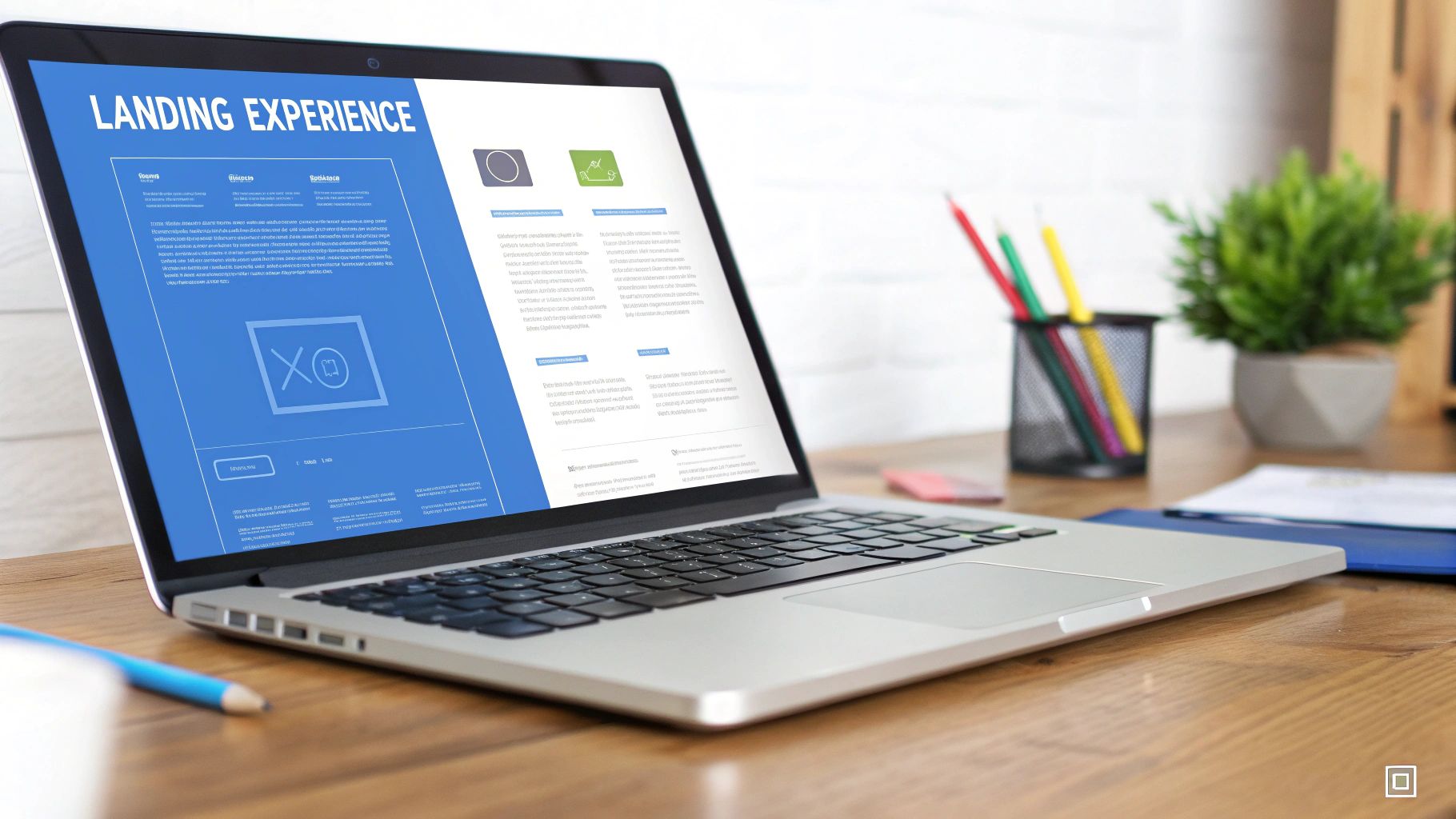Think of your ad as a promise. Your landing page is where you deliver on it.Google puts a ton of weight on this part of the user journey, making the landing page experience a massive piece of your Quality Score. This isn't just about getting conversions; it's about proving to the algorithm that you provide a seamless, trustworthy, and genuinely helpful experience from the first click to the final action.Honestly, a bad landing page is one of the fastest ways to tank your Quality Score. If people click your ad and immediately hit the back button because the page is slow, confusing, or just plain wrong, you're screaming negative signals at Google.Let's dig into how to build pages that get rewarded.### The Power of Perfect Message MatchThe absolute golden rule of a high-quality landing page is **message match**. It’s simple: the headline, the copy, and the offer on your page have to be a direct continuation of what your ad promised.If your ad shouts "**50% Off Running Shoes**," your landing page better have a big, bold headline that says "**50% Off Running Shoes**." It's that direct.This immediate confirmation tells the user they’ve landed in the right spot. It kills confusion, lowers bounce rates, and starts building trust right away. Any disconnect, no matter how small, creates doubt and usually means a lost customer and a "Below average" score.Imagine running an ad for "Emergency Plumbing Services." The user clicks, stressed and needing a phone number *now*. But instead, they hit your generic homepage with a list of all your services. That’s a classic message mismatch, and that potential customer is already gone.### Nail the Technical Foundations FirstBefore you even touch the copy or design, your page's technical health has to be rock-solid. For Google and for users who expect everything instantly, two things are completely non-negotiable.* **Lightning-Fast Page Speed:** Every single second counts. A slow-loading page is the #1 killer of conversions. Use tools like Google's PageSpeed Insights to find and fix whatever is slowing you down. A faster page is a better user experience, period.* **Flawless Mobile Experience:** Most searches happen on a phone. Your landing page *must* be fully responsive and easy to use on a small screen. Can people easily tap the buttons? Are the forms a nightmare to fill out? Fix it.These aren't just "best practices" anymore; they're the absolute minimum for getting a positive landing page experience score.> Your landing page must deliver exactly what the user was searching for, in the exact way your ad said it would. Consistency is the key to building the trust that underpins a great Quality Score.### Build Trust with E-E-A-T PrinciplesGoogle wants to send its users to pages that are credible and authoritative. This is where the principles of **Experience, Expertise, Authoritativeness, and Trustworthiness (E-E-A-T)** come in. We usually talk about this for organic SEO, but these signals are just as critical for your paid landing pages.You can show off your E-E-A-T by including:* **Clear Contact Information:** Don't hide it. Make your business address, phone number, and email easy to find.* **Customer Testimonials or Reviews:** Social proof is unbelievably powerful. Let your happy customers do the selling for you.* **Trust Badges:** Got security seals, industry awards, or partner logos? Show them off.* **Transparent Policies:** Have clear links to your privacy policy and terms of service.These elements prove to users and Google that a real, trustworthy business is behind the page. To really dial this in, you should be constantly refining these trust elements through [A/B testing for landing pages](https://www.pages.report/blog/a-b-testing-for-landing-pages).### Create an Intuitive and Clear User PathYour landing page should have one goal and one goal only. A cluttered page with a dozen different things to click just forces the user to think, which usually means they'll just leave. Every single thing on the page should guide them toward that one conversion action.Start by defining the one thing you want a visitor to do. Fill out a form? Make a purchase? Download a guide?Once you know the goal, structure the page to make it dead simple.1. **Use a Clear, Benefit-Oriented Headline:** This is your first chance to reinforce that message match.2. **Employ Persuasive, Scannable Copy:** Nobody reads walls of text. Use short paragraphs, bullet points, and subheadings.3. **Include a Compelling Call-to-Action (CTA):** Your CTA button needs to pop. Use bright colors and action-focused text like "Get Your Free Quote" instead of a boring "Submit."By turning your landing page into a high-performing asset, you make the user's decision easy and send all the right signals to Google. Our guide on crafting a [high-converting landing page](https://landermagic.com/blog/high-converting-landing-page) has even more strategies to help you get this right.## How to Write Ads That Beg to Be ClickedA high Expected Click-Through Rate (eCTR) is the loudest signal you can send Google that your ad is a perfect match for a user's query. But let's be real—in a sea of competing ads, how do you make yours the one that gets the click?It’s less about being a creative writer and more about understanding the science of persuasion. You have to get inside the searcher's head and craft an ad they simply can't ignore.<iframe width="100%" style="aspect-ratio: 16 / 9;" src="https://www.youtube.com/embed/EqEvSuh6Syo" frameborder="0" allow="autoplay; encrypted-media" allowfullscreen></iframe>Your eCTR is Google's prediction of how likely your ad is to be clicked. A score of "Above average" tells the algorithm you're hitting the mark, which directly pumps up your Quality Score.Every single part of your ad—from the headline to the description—has to work together to answer one simple question for the user: "Is this *exactly* what I'm looking for?"Let's break down how to build ads that consistently get that "yes."### Tapping into User Psychology for Higher ClicksThe best ads don't just list features. They speak directly to the user's needs, fears, or desires, creating a connection that makes clicking feel like the obvious next step.This is where you move beyond generic copy and start pulling emotional triggers. What problem is your customer desperately trying to solve *right now*?* **Create Urgency:** Simple phrases like "Limited Time Offer" or "Sale Ends Friday" tap into the fear of missing out (FOMO) and push people to act now, not later.* **Highlight a Unique Value Proposition (UVP):** What do you offer that your competitors don't? Is it "Free Next-Day Shipping" or "Guaranteed for Life"? Put your single biggest selling point front and center.* **Use Social Proof:** Numbers build trust. Phrases like "Join **50,000+** Happy Customers" instantly reduce friction for someone on the fence.Focus on the *why* behind their search. If your ad makes the user feel understood, you're on the right track.### The Art of A/B Testing Your Ad CopyGuesswork is the enemy of a high-performing Google Ads account. You need a solid framework for testing your ad copy to find out what truly moves the needle. The whole point of A/B testing is to make small, iterative changes to isolate what drives clicks.Stop guessing and start making decisions with data.A simple A/B test could be running two ads in the same ad group that are identical except for one thing—the headline.> For example, you might test "Durable Hiking Boots for Men" against "Conquer Any Trail with Our Hiking Boots." The first is descriptive and keyword-focused. The second is benefit-driven and plays on emotion. Let the data tell you which one wins.This cycle of testing and refining is how you systematically improve your eCTR and, in turn, your Quality Score. And don't just stop at headlines. Test your descriptions, calls to action (CTAs), and even your display paths.### Using Negative Keywords to Boost eCTROne of the most powerful—and weirdly overlooked—ways to improve your eCTR is by telling Google what searches you *don't* want to show up for. This is the magic of **negative keywords**.Think about it. Every time your ad shows for an irrelevant search, it’s an impression that's almost guaranteed *not* to get a click. That tanks your eCTR and wastes your budget.Imagine you sell premium, high-end furniture. You definitely don't want your ads showing up for searches like "cheap furniture" or "used sofas." By adding "cheap" and "used" as negative keywords, you instantly filter out unqualified searchers who were never going to buy from you anyway.This simple act ensures your ad is only shown to a highly relevant audience that is far more likely to click. The result? A naturally higher eCTR because every impression has a better shot at becoming a click. A well-maintained negative keyword list isn't a "nice-to-have"—it's a non-negotiable part of improving your Quality Score.## A Step-by-Step System for Auditing and Improving Quality ScoreIndustry benchmarks for Google Ads in 2025 show that this intense focus on engagement pays off. A good click-through rate now averages between **4–6%**, but this figure can swing wildly depending on the industry. In competitive legal fields, a **2%** CTR might be excellent, while for an e-commerce store, **6%** could be underperforming. This just goes to show why context and constant optimization are so critical. To get a better handle on these metrics, you can [discover more insights about 2025 Google Ads benchmarks on TerraHQ.com](https://terrahq.com/blog/google-ads-benchmarks-2025/).Improving your Quality Score isn't a one-and-done deal; it's a constant process of tweaking and refining. If you don't have a repeatable system, you're basically just throwing darts in the dark. This framework will give you a clear process to audit your account's health, figure out what's broken, and focus your efforts where they'll actually move the needle.So, where do you begin? The first step is getting the right data front and center in your Google Ads account.### Set Up Your Diagnostic ViewBefore you can fix anything, you need to know exactly what's wrong. Head over to your keywords report in Google Ads and hit "Customize columns." The final 1-10 score is just the tip of the iceberg; you need to see the components that make it up.Make sure you add these columns to your report:* **Quality Score:** The overall 1-10 score.* **Exp. CTR:** Your Expected Click-Through Rate status ("Average," "Above average," or "Below average").* **Ad Relevance:** Your Ad Relevance status.* **Landing page exp.:** Your Landing Page Experience status.* **Impressions:** This helps you see which keywords actually have enough data to be significant.With this setup, you can see *at a glance* why a keyword has a low score. Is it a landing page problem? Is your ad copy falling flat? Think of this view as your personal diagnostic dashboard.This simple infographic breaks down the three core steps for a solid Quality Score audit.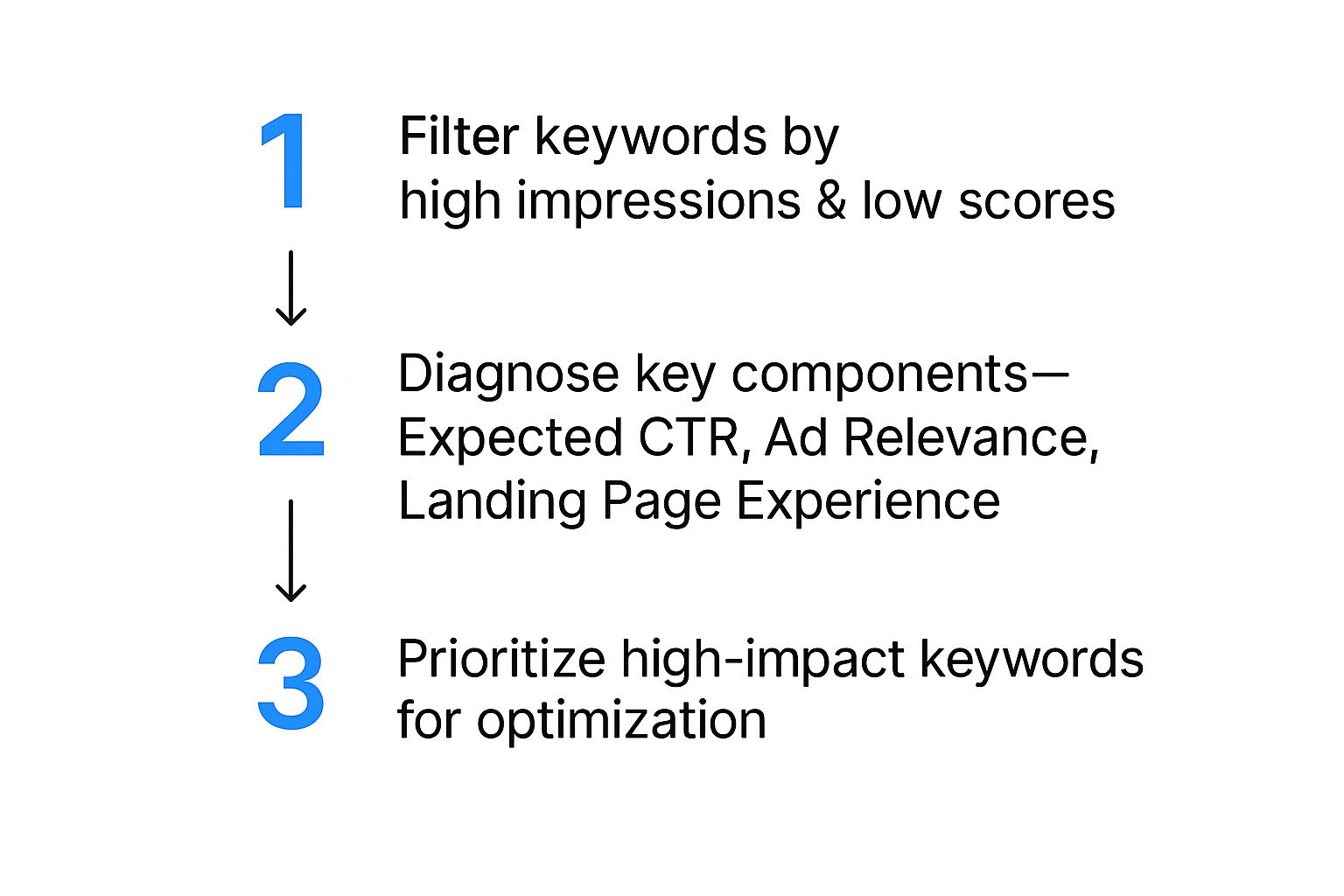As you can see, it all starts with filtering for your high-impact keywords, then diagnosing the real issue, and finally, making targeted optimizations.### How to Prioritize Your Optimization EffortsYou can’t fix everything at once, and you shouldn't try. Effective auditing is all about ruthless prioritization. You have to put your limited time and energy where you'll get the biggest bang for your buck.Start by sorting your keywords by **impressions**. This instantly brings the keywords getting the most eyeballs to the top. A keyword with **5,000** monthly impressions and a 4/10 Quality Score is a much bigger problem—and a much bigger opportunity—than a keyword with only 20 impressions and the same score.> Focus on keywords with high impressions but a Quality Score of 6 or below. Even a small improvement on these high-volume terms can lead to a massive drop in your average cost-per-click (CPC) and a serious boost in traffic.Once you’ve got your high-priority keywords identified, look at the component scores. If "Landing page exp." is flagged as "Below average" for a whole group of your top keywords, you know exactly where to start digging. This kind of targeted approach is the cornerstone of any successful [Google Ads campaign optimization](https://landermagic.com/blog/google-ads-campaign-optimization) strategy.To make this process more systematic, I've put together a checklist you can follow.### Quality Score Audit ChecklistThis table provides a structured way to walk through your account, ensuring you don't miss any critical steps. It turns a messy audit into a clear, repeatable process.| Audit Step | Metric to Check | Action to Take if Below Average || :--- | :--- | :--- || **1. High-Impact Keyword Identification** | Sort keywords by Impressions. | Focus on keywords with significant impression volume and a QS of 6 or lower. || **2. Ad Relevance Diagnosis** | Check "Ad Relevance" status for your top keywords. | Rewrite ad copy to better align with keyword themes in the ad group. || **3. CTR Diagnosis** | Review "Exp. CTR" status. | Test new headlines, descriptions, and calls-to-action to improve ad appeal. || **4. Landing Page Experience Diagnosis**| Examine "Landing page exp." status. | Audit the landing page for relevance, load speed, and user experience. || **5. Track Historical Performance** | Add historical QS columns to your view. | Monitor changes over time to validate the impact of your optimizations. |By following this checklist, you can methodically identify weaknesses and turn them into strengths, directly impacting your campaign's performance and profitability.### Interpreting the Data and Tracking ProgressAfter you’ve rolled out your changes—whether that’s rewriting ad copy or overhauling a landing page—you have to track your progress. Don't expect your Quality Score to jump overnight. It can take days, sometimes even weeks, for Google to re-evaluate your ads and update the score.To see if your work is paying off, add the historical Quality Score columns to your view:* **Qual. score (hist.)*** **Landing page exp. (hist.)*** **Ad relevance (hist.)*** **Exp. CTR (hist.)**By segmenting your data by week or month, you can directly connect your optimization efforts to score improvements. Did the scores for an ad group start climbing after you launched that new ad copy? This is how you prove your strategy is working.## Got Questions About Quality Score?It’s completely normal to have questions when you're digging into the weeds of Quality Score. It's one of those metrics that feels a bit like a black box at first. After you've started tweaking ads and landing pages, a few common uncertainties always seem to bubble up.Let's clear the air and tackle the questions I hear most often from advertisers trying to crack the Quality Score code.### How Long Does It Take to See Quality Score Improvements?Patience is the name of the game here. I know it's frustrating, but changes to Quality Score almost never happen overnight. After you’ve pushed a new batch of optimized ad copy or revamped a landing page, Google needs time. It can take anywhere from a few days to several weeks for the system to gather enough impression data, re-evaluate your changes, and finally update the score.The most important thing is to be consistent with your improvements. Focus on making changes that genuinely help the user, and make a habit of checking your scores weekly. As a general rule, you'll likely see shifts in Ad Relevance and Expected CTR show up faster than Landing Page Experience, since Google's landing page analysis is a much more involved process.### Does a Low Score on One Keyword Hurt My Whole Account?Yes and no. While Quality Score is officially calculated for each individual keyword, the ripple effects are definitely real. A large number of keywords with low scores can start to drag down the performance perception of the entire ad group, and sometimes even the campaign.Think of it like a credit score for your account. Google’s algorithms look at your historical performance. If it sees a long history of poor-performing keywords, it assumes there’s a disconnect between your ads and what users are looking for. This can put new keywords in that ad group at a disadvantage, like they're starting the race a few steps behind the starting line.> **My Pro Tip:** Be ruthless with your spring cleaning. Proactively pause any keywords with a score of **3/10 or below** that aren't getting many impressions anyway. This tidies up your account's history and helps Google’s algorithm focus on the quality of your top-performing terms.### Is a Perfect 10 Out of 10 Quality Score a Realistic Goal?Honestly, chasing a perfect **10/10** on every single keyword is a recipe for madness. It's often not the most strategic use of your time and budget. For the vast majority of well-run accounts, having your scores consistently sitting in the **7 to 10** range is the sign of a healthy, successful setup.The smart approach is to prioritize. Go after that elusive **10/10** for your absolute most important, highest-volume keywords—the ones that are the lifeblood of your traffic and conversions. That's where you'll see the biggest financial win from lower CPCs. For your broader, supporting keywords, a score of 7 or 8 is a fantastic result that shows you're doing things right.Don't let the pursuit of perfection stop you from achieving excellent results across the board. Focus your energy where it delivers the biggest impact.---Ready to finally get your landing page experience out of the "Average" slump and into "Above Average" territory? **LanderMagic** is built to create lightning-fast, hyper-relevant landing pages that perfectly align with user intent—giving Google exactly what it wants to see. [Start building pages that boost your Quality Score at landermagic.com](https://landermagic.com).
Make a x3 on your Google Ads conversion rate!
Create unique experience for each Google Ads visitor in no time. Start unsing LanderMagic today.
Try for free

